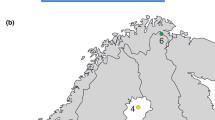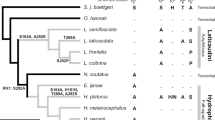Abstract
-
1.
Interspecific diversity in the visual pigments of stomatopod crustaceans was characterized using microspectrophotometry. We examined the 10 visual pigments in main rhabdoms in retinas of 3 species of each of two genera of stomatopod crustaceans of the superfamily Gonodactyloidea, Gonodactylus (G. oerstedii, G. aloha, and G. curacaoensis) and Odontodactylus (O. scyllarus, O. brevirostris, and O. “havanensis”). Species were selected to provide a matched diversity of habitats.
-
2.
In each genus, visual pigments varied in λmax in several regions of the retina, as revealed by analysis of variance. The variation within closely related species of the same genus implies that visual pigments can evolve rapidly in stomatopods.
-
3.
In photoreceptors of the peripheral retina, which are devoted to spatial vision, visual pigment λmax decreased as the depth range of the various species increased, a typical pattern for marine animals. In contrast, visual pigment λmax in photoreceptors of retinal regions devoted to polarization vision (midband Rows 5 and 6) is not obviously correlated with the spectral environment, implying that polarization information may be confined to particular spectral ranges. Visual pigments of the tiered rows of the midband, which are committed to spectral analysis, span a larger spectral range in shallow-water than deepwater species.
Similar content being viewed by others
Abbreviations
- MSP :
-
microspectrophotometry
References
Applebury ML, Hargrave PA (1986) Molecular biology of the visual pigments. Vision Res 26: 1881–1985
Bernard GD (1987) Spectral characterization of butterfly L-receptors using extended Dartnall/Macichol template functions. J Opt Soc Am A4: 123
Bernard GD, Remington CL (1991) Color vision in Lycaena butterflies: Spectral tuning of receptor arrays in relation to behavioral ecology. Proc Natl Acad Sci USA 88: 2783–2787
Bowmaker JK, Astell S, Hunt DM, Mollon JD (1991) Photosensitive and photostable pigmetns in the retinae of old world monekeys. J Exp Biol 156: 1–19
Bridges CDB (1972) The rhodopsin-porphyropsin visual system. In: Dartnall HJA (ed) Photochemistry of vision (Handbook of sensory physiology, vol VII/1). Springer, Berlin Heidelberg New York, pp 417–480
Bridges CDB, Delisle CE (1974) Evolution of visual pigments. Exp Eye Res 18: 323–332
Bridges CDB, Yoshikami S (1970) Distribution and evolution of visual pigments in salmonid fishes. Vision Res 10: 609–626
Chittka L, Menzel R (1992) The evolutionary adaptation of flower colors and the insect pollinators' color vision. J Comp Physiol A 171: 171–181.
Crescitelli F (1978) The chloride ionochromic response: an in situ effect. Vision Res 18: 1421–1422
Cronin TW, Forward RB Jr (1988) The visual pigments of crabs. I. Spectral properties. J Comp Physiol A 162: 463–478
Cronin TW, Marshall NJ (1989a) Multiple spectral classes of photo-receptors in the retinas of gonodactyloid stomatopod crustaceans. J Comp Physiol A 166: 267–275
Cronin TW, Marshall NJ (1989b) A retina with at least ten spectral types of photorecptors in a stomatopod crustacean. Nature 339: 137–140
Cronin TW, Yan HY, Bidle KD (1992) Regional specialization for control of ocular movements in the compound eyes of a stomatopod crustacean. J Exp Biol 171: 373–393
Cronin TW, Marshall NJ, Caldwell RL (1993) Photoreceptor spectral diversity in the retinas of squilloid and lysiosquilloid stomatopod crustaceans. J Comp Physiol A 172: 339–350
Cronin TW, Marshall NJ, Caldwell RL, Shashar N (1994a) Specialization of retinal function in the compound eyes of mantis shrimps. Vision Res 34: 2639–2656
Cronin TW, Marshall NJ, Caldwell RL (1994b) The retinas of mantis shrimps from low-light environments (Crustacea; Stomatopoda; Gonodactylidae). J Comp Physiol A 174: 607–619
Cronin TW, Marshall NJ, Caldwell RL (1994c) The intrarhabdomal filters in the retinas of mantis shrimps. Vision Res 34: 279–291
Cronin TW, Marshall NJ, Caldwell RL, Pales D (1995) Compound eyes and ocular pigments of crustacean larvae (Stomaopoda and Decapoda, Brachyura). Mar Fresh Behav Physiol 26: 219–231
Goldsmith TH (1990) Optimization, constraint and history in the evolution of eyes. Q Rel Biol 65: 281–322
Goldsmith TH, Cronin TW (1993) The retinoids of seven species of mantis shrimp. Visual Neurosci 10: 915–920
Hargrave PA, McDowell JH, Curtis DR, Wang JK, Juszczak E, Fong S-L, Mohana Rao JK, Argos P (1983) The structure of bovine rhodopsin. Biophys Struct Mech 9: 235–244
Ivanoff A, Waterman TH (1958) Factors, mainly depth and wavelength, affecting the degree of underwater light polarization. J Mar Res 16: 283–307
Jacobs GH (1993) The distribution and nature of colour vision among the mammals. Biol Rev 68: 413–471
Manning RB (1969) Stomatopod Crustacea of the Western Atlantic. Studies in Tropical Oceanography No. 8. Institute of Marine Sciences, University of Miami, 380 pp
Marshall NJ (1988) A unique colour and polarisation vision system in mantis shrimps. Nature 333: 557–560
Marshall NJ, Land MF, King CA, Cronin TW (1991a) The compound eyes of mantis shrimps (Crustacea, Hoplocarida, Stomatopoda). I. Compound eye structure: The detection of polarised light. Phil Trans R Soc Lond B 334: 33–56
Marshall NJ, Land MF, King CA, Cronin TW (1991b) The compound eyes of mantis shrimps (Crustacea, Hoplocarida, Stomatopoda). II. Colour pigments in the eyes of Stomatopod crustaceans: Polychromatic vision by serial and lateral filtering. Phil Trans R Soc Lond B 334: 57–84
Menzel R, Schmida A (1993) The ecology of flower colours and the natural colour vision of insect pollinators: The Israeli flora as a study case. Biol Rev 68: 81–120
Merbs SL, Nathans J (1992) Absorption spectra of the hybrid pigments responsible for anomalous color vision. Science 258: 464–466
Mollon JD (1989) “The she kneel'd in the Place where they grew ...” The uses and origins of primate colour vision. J Exp Biol 146: 21–38
Motoyama H, Hamanaka T, Kito Y, Morita H, Guerette L, Abran D, Boucher F (1986) Wavelength modulation by molecular environment in visual pigments. Biochim Biophys Act 861: 9–15
Nagle MG, Osorio D (1993) The tuning of human photopigments may minimize red-green chromatic signals in natural conditions. Proc R Soc Lond B 252: 209–213
Nathans J, Thomas D, Hogness DS (1986) Molecular genetics of human color vision: The genes encoding blue, green, and red pigments. Science 232: 193–202
Neitz J, Neitz M, Jacobs GH (1989) Analysis of fusion gene and encoded photopigment of color-blind humans. Nature 342: 679–682
Neitz M, Neitz J, Jacobs GH (1991) Spectral tuning of pigments underlying red-green color vision. Science 252: 971–974
Neitz M, Neitz J, Grishok A (1995) Polymorphism in the number of genes encoding long-wavelength-sensitive cone pigments among males with normal color vision. Vision Res 35: 2395–2407
Osorio D, Bossomaier TRJ (1992) Human cone-pigment spectral sensitivities and the reflectances of natural surfaces. Biol Cybern 67: 217–222
Peitsch D, Fietz A, Hertel H, DeSousa J, Ventura DF, Menzel R (1992) The spectral input systems of hymenopteran insects and their receptor-based colour vision. J Comp Physiol A 170: 23–40
Schiff H, Candone P (1986) Superposition and scattering of visual fields in a compound, double eye-II. Stimulation sequences for different distances in a Stomatopod from a bright habitat. Comp Biochem Physiol 83A: 445–455
Seliger H, Lall AB, Biggley WH (1994) Blue through UV polarization sensitivities in insects. Optimizations for the range of atmospheric polarization conditions. J Comp Physiol A 175: 475–486
Sokal RR, Rohlf FJ (1969) Biometry. WH Freeman, San Francisco, p 776
Vandermeer HJ, Bowmaker JK (1995) Interspecific variation of photoreceptors in four co-existing haplochromine cichlid fishes. Brain Behav Evol 45: 232–240
Author information
Authors and Affiliations
Rights and permissions
About this article
Cite this article
Cronin, T.W., Marshall, N.J. & Caldwell, R.L. Visual pigment diversity in two genera of mantis shrimps implies rapid evolution (Crustacea; Stomatopoda). J Comp Physiol A 179, 371–384 (1996). https://doi.org/10.1007/BF00194991
Accepted:
Issue Date:
DOI: https://doi.org/10.1007/BF00194991




